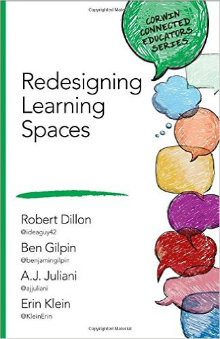A Glance at Redesigning Learning Spaces
Redesigning Learning Spaces
By Robert Dillon, Ben Gilpin, A.J. Juliani and Erin Klein
(Corwin Connected Educators Series, 2016 – Learn more)
 Reviewed by Rita Platt
Reviewed by Rita Platt
Any teacher who is a part of an online community, be it Facebook, Pinterest, or Twitter, is aware of the classroom design revolution. From natural lighting, to community learning spaces, to seating that allows and even encourages movement, classrooms are becoming more like coffee houses than like the six by six rows of desks facing a blackboard – the standard of our youth.
 This slim book (72 pp.) starts by extolling this new vision of learning spaces, saying, “It is time for desks to lose and the children to win!” (p. 2). The authors claim that this perspective will bring “hope, joy, and positive energy back to the daily work of the classroom” (p.2).
This slim book (72 pp.) starts by extolling this new vision of learning spaces, saying, “It is time for desks to lose and the children to win!” (p. 2). The authors claim that this perspective will bring “hope, joy, and positive energy back to the daily work of the classroom” (p.2).
While I would argue that hope, joy, and positive energy were never missing from many classrooms, the basic idea is easy to agree with: Students and teachers spend far too much time in classrooms for them to be anything less than joyful, comfortable, and conducive to learning. Simply put, “Learning spaces matter” (p. 22).
Unfortunately, this book did not offer much in the way of strong advice, resources or examples of how to make meaningful changes. There is only one picture of a redesigned classroom and few real tips. Rather the bulk of the text is devoted to a hodgepodge of high-minded rationales for school and classroom space reform. The authors themselves acknowledge that this book will “ask more questions than it answers” (p. 2).
There are five chapters:
- Leading Change Through Classroom Learning Space Redesign: A disparate set of ideas are shared here. This includes a discussion of the value of a minimalistic, monochromatic room and a room that showcases “beauty” (though the concept is not clearly defined). There is also an example of a teacher who redid her bookshelves so that all of the books were facing spine out. Last, there is a somewhat confusing plea for teachers to stop laminating things.
- Learning Space Change as a Lever to Shift School Culture: This chapter starts with the question, “When you walk into a room, do you feel a vibe?” (p.11). In the best cases, that vibe captures what the authors call the “4 Cs” (p. 15); collaboration, creativity, critical thinking, and communication. Despite the discussion of beauty in the first chapter, there is a note here about how classrooms don’t have to look nice. They comment that redesign is about creating user friendly spaces using the materials we have at hand.
- Shaping Learning Space Change for the Community: Here the authors work to convince the reader that school redesign can be a catalyst for changing the surrounding community for the better. There are some troubling aspects in this chapter. There are statistics shared with little convincing citation and an over-reliance on the “Broken Window Theory.” This metaphor states that even minor breakdowns of order signal that the system can’t be controlled in general, emboldening poor behavior choices from the surrounding community. The idea in the book seems to be, if classrooms and schools are warm, inviting spaces, the rest of the community might follow suit. The authors cite a 1982 study for support. However the “Broken Window Theory” has long been debunked.
- Learning Space as a Lever for Systemic Change: This is another chapter that seemed somewhat muddled to me. The main ideas seem to be that all change should be driven by learning goals and needs with an eye to what students will require in the future. Mostly, it felt above and beyond what the book’s title would lead one to believe about the pages inside.
- Models of Excellence and Where to Start: There is scant helpful information in this short chapter. It does, however, have the book’s one photograph of a resigned classroom and it looks great!
Find the book’s website resources here.
A sincere but unhelpful book
The bottom line is, while I admire the authors and found them to be sincere in their hopes for classroom redesign as a driver for school reform and even community amelioration, the book falls short of being helpful for teachers in their everyday quest to make their classrooms warmer, smarter, better.
One place to get more practical information on classroom redesign is right here on MiddleWeb. Read Emily Vickery’s post, Are You Hacking Your School’s Learning Spaces? And Flexible Seating and Student-Centered Classroom Redesign from Edutopia is also excellent.
Last, fool around with Classroom Architect’s interactive floor planning tool to get a feel for how your redesigned space could look before you drag all those desks out in the hallway.
Classroom redesign in an important topic, but Redesigning Learning Spaces does not offer a clear blueprint.
Rita Platt (@ritaplatt) is a Nationally Board Certified teacher with master’s degrees in reading, library, and leadership. Her experience includes teaching learners in remote Alaskan villages, inner cities, and rural communities. She currently is a teacher-librarian, teaches graduate courses for the Professional Development Institute, and writes for We Teach We Learn.

































